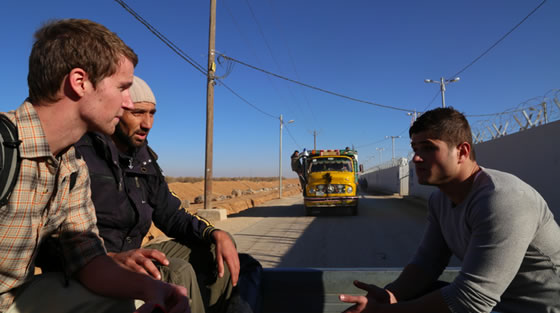 Darkness clouds the path. Babies and young children are passed from person to person over treacherous terrain. Specs of light on distant horizons leave the hundreds of scurrying feet with only minor bearings as they flee their warring homeland. We begin the documentary Salam Neighbor with a montage of families emigrating Syria in secret. With this intro, lit only by flashlight and shot handheld, directors Zach Ingrasci and Chris Temple find a way to pull you into the human drama inside the refugee crisis from the get-go. Then through a series of new blurbs, the filmmakers connect themselves to the conflict and explain the goal of Salam Neighbor: to move onto a Syrian refugee camp and discover what the day-to-day life is like for the people who live there.
Darkness clouds the path. Babies and young children are passed from person to person over treacherous terrain. Specs of light on distant horizons leave the hundreds of scurrying feet with only minor bearings as they flee their warring homeland. We begin the documentary Salam Neighbor with a montage of families emigrating Syria in secret. With this intro, lit only by flashlight and shot handheld, directors Zach Ingrasci and Chris Temple find a way to pull you into the human drama inside the refugee crisis from the get-go. Then through a series of new blurbs, the filmmakers connect themselves to the conflict and explain the goal of Salam Neighbor: to move onto a Syrian refugee camp and discover what the day-to-day life is like for the people who live there.
The camp, Za’atari, is located in Jordan and is only seven miles from Syria. Sounds of warring factions and bombs echo over the boarder constantly. Over 70,000 refugees live inside. The site is strewn with trailers and tents, all colored in an identical tan. At first, it’s a community that would seem easy to get lost in, but thanks to the spurts of graffiti and clothes there is human warmth felt across the otherwise dull camp. Within the first day at the refugee camp, the security force informs the directors it is unsafe to stay through the night. To rectify the situation, the crew must leave during the night to stay in the bordering town of Mafraq. Despite these warnings of violence early on, no aggression is ever shown to the filmmakers. In fact, quite the opposite, from day one the refugees are welcoming and willing to share their experience. They even set up the crew’s entire tent for them, in addition to sharing their food and games.
 Though never really glimpsing what night is like on the camp, the filmmakers do a noble job of humanizing people within the crisis that might have before just been seen as statistics. A connection forms over the course of the film with numerous refugees whose perseverance stand out. One young boy named Raouf was inside a school in Syria during a bombing. Traumatized, he’s been unable to attend any school since. However, something you might not have expected, at the camp there are refugees taking this chance to help their countrymen affected by war. And kids, like Raouf, are being taught to feel safe and learn again.
Though never really glimpsing what night is like on the camp, the filmmakers do a noble job of humanizing people within the crisis that might have before just been seen as statistics. A connection forms over the course of the film with numerous refugees whose perseverance stand out. One young boy named Raouf was inside a school in Syria during a bombing. Traumatized, he’s been unable to attend any school since. However, something you might not have expected, at the camp there are refugees taking this chance to help their countrymen affected by war. And kids, like Raouf, are being taught to feel safe and learn again.
Insights are made throughout the documentary into the good refugees do for their own. It becomes a testament to the gap that is between public perception and the reality of the Syrian’s situation. Most of the global population that might feel Syrians are looking for a handout, but watch this film and find a people working to take their war-torn lives into their own hands.
Salam Neighbor gives a name and a face to the Syrian refugee crisis, filling you with a more personal understanding of the struggle. Hopefully, when this documentary reaches a wider audience, it can do some good in helping to illustrate common human bond of endurance through disaster that is shared between all communities around the world.

